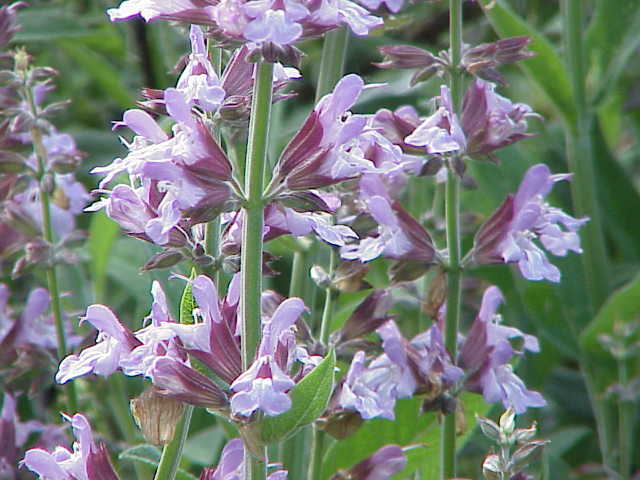Variegated Sage (Salvia officinalis) is a perennial herb that is native to the Mediterranean region. It is characterized by its green leaves with white or cream-colored stripes running along the length of the leaf. The plant typically grows to a height of 2-3 feet and has a spread of 1-2 feet.
Variegated Sage is easy to grow and is tolerant of most soil types and environmental conditions. It thrives in full sun but can also grow in partial shade. Variegated Sage is an ideal plant for use in borders, rock gardens, or as a groundcover.
It is also well suited for growing in containers. When grown in the landscape, Variegated Sage will form a nice mound that is covered in blooms from late spring through early summer.

Essentials

Soil
If you’re looking to grow Variegated Sage, it’s important to keep a few things in mind regarding soil composition and pH level.
This plant thrives in sandy, well-drained soil with a pH level of 6.5-7.5. Soil that is too sandy will not hold enough moisture, while soil that is too clay-like will be too dense and prevent proper drainage.
Variegated Sage also prefers full sun exposure, so make sure to choose a planting spot that gets at least 6 hours of direct sunlight per day. With these conditions met, you’ll be on your way to growing healthy and vibrant Variegated Sage plants.
Watering
Growing Variegated Sage requires well-drained soil and full sun to partial shade. Water the plant regularly during the growing season, allowing the soil to dry out slightly between waterings. While growing in containers, Variegated Sage needs to be watered more frequently. During the winter months, cut back on watering to allow the plant to go dormant.
Flowering
Variegated Sage is a beautiful addition to any flower garden. It’s easy to grow and doesn’t require much care. Follow these simple tips and you’ll be enjoying its blooms in no time. Flowers are produced from late spring to early summer.
To grow Variegated Sage, start by planting the seeds in a sunny spot with well-drained soil. Water the seeds regularly, and thin out the seedlings once they’ve grown a few inches tall. When the plants are about six inches tall, pinch back the tips to encourage bushier growth.
Variegated Sage blooms from late spring to early summer, and deadheading the spent flowers will encourage even more blooming. The flowers are two-lipped, tubular-shaped, and range in color from blue to purple.
Fruiting
Variegated sage is a herbaceous perennial that originates from Mexico. It is a typically sub-shrub that can grow up to 1 meter in height. The leaves are opposite, ovate-lanceolate shaped, and green-grey in color with white margins. The fruits of variegated sage are small, dry, and black. Fruits appear from mid to late summer. Variegated Sage can be harvested when fruits are ripe.
Propagation
Variegated Sage is easy to grow and can be propagated by seed or cuttings. Cuttings can be taken from new growth in spring or summer. Variegated Sage is not frost-tolerant and should be protected from cold temperatures. To grow Variegated Sage, sow seeds in early spring or propagate by softwood cuttings taken in late spring or early summer. Plants will reach a height of 1-3 feet and a spread of 2-3 feet.
When growing Variegated Sage, make sure to give the plant enough room to spread as it can become invasive if left unchecked.
Benefits of Variegated sage plant
Just like some other varieties of sage plants, variegated sage contains natural anti-inflammatory, antiseptic antibacterial and anti-spasmodic properties. It may be consumed as tea or externally as essential oil extracts. The plant is also helpful in curing digestive problems, including loss of appetite, stomach pain, diarrhoea, bloating and heartburn, etc.
Variegated sage is also helpful in reducing the overproduction of perspiration and saliva and preventing depression, memory loss and other age-related diseases. The powerful anti-bacterial and anti-microbial properties of this plant help to prevent infections and act as a protective shield.
Pests and diseases
It is important to be aware of the potential pest and disease problems that can affect this plant. The most common pests are aphids, whiteflies, and spider mites. These pests can damage the leaves of the plant, causing them to turn yellow or brown. Diseases that can affect the Variegated Sage include powdery mildew and root rot.
Powdery mildew is a white powdery fungus that can grow on the leaves of the plant, while root rot is a condition that can cause the roots of the plant to rot. If you notice any of these problems with your Variegated Sage, be sure to take action immediately in order to prevent further damage.
Irritation to pets
The Variegated Sage is a beautiful plant that can add interest to any garden. However, it is important to be aware that the plant can cause irritation to pets if they come into contact with it. The best way to grow Variegated Sage is in an area that is not accessible to pets, such as in a raised bed or on a balcony.
Alternatively, you can grow the plant in a pot and place it on a high shelf where pets cannot reach it. If you do choose to grow Variegated Sage, be sure to keep an eye on your pets and monitor them for any signs of irritation.






